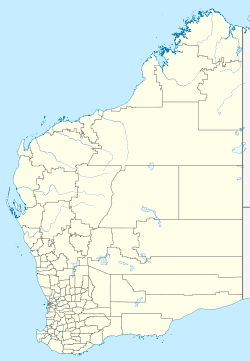- Drysdale River National Park
-
Drysdale River National Park Location Kimberly region, Western Australia Nearest city Kalumburu Coordinates 15°09′41″S 126°46′35″E / 15.16139°S 126.77639°ECoordinates: 15°09′41″S 126°46′35″E / 15.16139°S 126.77639°E Area 448,264 ha (1,107,680 acres)[1] Established 1974 Governing body Department of Environment and Conservation Official website Drysdale River National Park is a national park in the Kimberley region of Western Australia (Australia), 2,168 kilometres (1,347 mi) northeast of Perth.
The park lies about 100 km (62 mi) south of Kalumburu and 150 km (93 mi) west of Wyndham.[2]
The park is the largest and least accessible in the Kimberley with no public road leading to it and no airstrip within its boundaries.[3] Access to the park is gained via the track from Carson River Station from the Kalumburu Road. Permission must be obtained from the Kalumburu Aboriginal Corporation prior to entering the park. There are no visitor facilities or marked walk trails in the park. Rangers do not patrol the park and no food, fuel or mechanical services exist within the park or at Carson River Station.[4]
The park is a good example of untouched Kimberley wilderness featuring open woodland, gorges, cliffs and the pools, waterfalls and creeks of the Drysdale River. The park is home to two large waterfalls: Morgan Falls and Solea Falls with numerous smaller falls along the course of the river.
The area provides habitat for a large number of rare plants and animals. Almost 600 species of plants are known to exist within the park. About 30 of these plants are aquatic and swamp varieties that inhabit the permanent pools found along the Drysdale and Carson River. About 25 species of fern also inhabit the area, two of which are not found elsewhere. Species such as fan palms, kalumbaru gums and paperbarks are also found along the watercourses.[5]
A variety of fauna also exist within the park including over 100 species of birds, sugar gliders, bats, wallabies, and salt water crocodiles.[6]
The first European to visit the area was a surveyor with a squatting company, CA Burrowes, who did so in 1886. Both Brockman and Crossman visited the area in separate expeditions in 1901. The first vehicular track was constructed through the region during an expedition and survey in 1954, it ran from Gibb River Station to Kalumburu. The park was gazetted in September 1974, using the boundaries recommended by the Australian Academy of Science committee on National Parks in 1955.[7]
See also
References
- ^ Department of Environment and Conservation 2009–2010 Annual Report. Department of Environment and Conservation. 2010. pp. 48. ISSN 1835-114X. http://www.dec.wa.gov.au/content/view/6139/2345/.
- ^ "About Australia Travel Guides - Drysdale River National Park". 2008. http://www.about-australia.com/travel-guides/western-australia/australias-north-west/attractions/natural/drysdale-river-national-park/. Retrieved 2008-12-16.
- ^ "Drysdale River National Park". 2007. http://www.bushwalkingholidays.com.au/pdf/drys1.pdf. Retrieved 2008-12-16.
- ^ "Derby Tourism". 2008. http://www.derbytourism.com.au/pages/national-parks/. Retrieved 2010-05-05.
- ^ "Deprtment of Environment - Park Finder". 2010. http://www.naturebase.net/component/option,com_hotproperty/task,view/id,68/Itemid,755/. Retrieved 2010-05-05.
- ^ "About Australia-Drysdale River National Park". 2010. http://www.about-australia.com/travel-guides/western-australia/australias-north-west/attractions/natural/drysdale-river-national-park/. Retrieved 2010-05-05.
- ^ "Drysdale River National Park (entry AHD106017)". Australian Heritage Database. Department of Sustainability, Environment, Water, Population and Communities. 2010. http://www.environment.gov.au/cgi-bin/ahdb/search.pl?mode=place_detail;place_id=106017. Retrieved 2010-11-27.
National parks of Western Australia Alexander Morrison · Avon Valley · Badgingarra · Beedelup · Beelu · Boorabbin · Brockman · Cape Arid · Cape Le Grand · Cape Range · Collier Range · D’Entrecasteaux · Drovers Cave · Drysdale River · Eucla · Fitzgerald River · Francois Peron · Frank Hann · Geikie Gorge · Gloucester · Goongarrie · Gooseberry Hill · Greenmount · Gull Rock · Hassell · Hidden Valley · John Forrest · Kalamunda · Kalbarri · Karijini · Karlamilyi · Kennedy Range · Leeuwin-Naturaliste · Lesmurdie Falls · Lesueur · Millstream-Chichester · Mirima · Mitchell River · Moore River · Mount Augustus · Mount Frankland · Nambung · Neerabup · Peak Charles · Porongurup · Purnululu · Rudall River · Scott · Serpentine · Shannon · Sir James Mitchell · Stirling Range · Stokes · Tathra · Torndirrup · Tuart Forest · Tunnel Creek · Walpole-Nornalup · Walyunga · Warren · Watheroo · Waychinicup · West Cape Howe · William Bay · Windjana Gorge · Wolfe Creek Meteorite Crater · Yalgorup · YanchepCategories:- IUCN Category II
- National parks of Western Australia
- Kimberley (Western Australia)
- Protected areas established in 1974
Wikimedia Foundation. 2010.

